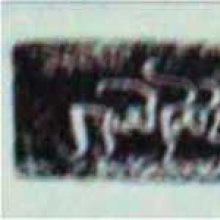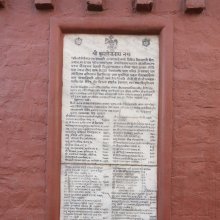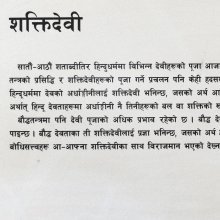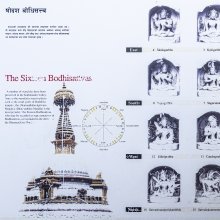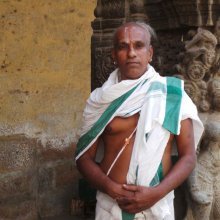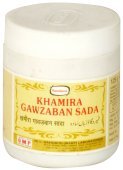Cata, Caṭa, Caṭā, Catā, Cāṭā, Cātā: 16 definitions
Introduction:
Cata means something in Hinduism, Sanskrit, the history of ancient India, Marathi, Hindi, biology, Tamil. If you want to know the exact meaning, history, etymology or English translation of this term then check out the descriptions on this page. Add your comment or reference to a book if you want to contribute to this summary article.
Cata has 15 English definitions available.
Alternative spellings of this word include Chata.
Images (photo gallery)
(+4 more images available)
Languages of India and abroad
Sanskrit dictionary
[Deutsch Wörterbuch]
Source: Cologne Digital Sanskrit Dictionaries: Böhtlingk and Roth Grosses Petersburger WörterbuchCaṭa (चट):—in krama s. [Weber’s Indische Studien 3, 251. fg.]
--- OR ---
Cāṭa (चाट):—m. Betrüger: cāṭataskaradurvṛttamahāsāhasikādibhiḥ . pīḍyamānāḥ prajāḥ [Yājñavalkya’s Gesetzbuch 1, 335] [?= Pañcatantra I, 390.] im Prākrit [Mṛcchakaṭikā 78, 13.] — Wohl von caṭ = cat .
--- OR ---
Cāṭa (चाट):—[Spr. 620, v. l. (Th. II, S. 328).] cāṭāḥ kārpaṭikāḥ krūrāḥ [Bhaviṣyapurāna] bei [AUFRECHT, Halāyudha] [Ind.] u. kārpaṭika . Inschr. in [Journ. of the Am. Or. S. 6, 539, 13.] fortune-teller [HALL] nach [COLEBR.] in Digest of Hindu Law 1, 311. Auf cāṭa folgt bhaṭa in der Inschrift und beide Wörter könnten auch zusammengefasst werden; vgl. cārabhaṭa .
Source: Cologne Digital Sanskrit Dictionaries: Sanskrit-Wörterbuch in kürzerer FassungCaṭa (चट):—in kramacaṭa.
--- OR ---
Cāṭa (चाट):—m. —
1) Betrüger , Spitzbube [Varāhamihira’s Yogayātrā 4,50.] [Hemādri’s Caturvargacintāmaṇi 1,39,17.] —
2) Wahrsager [Journal of the Asiatic Society of Bengal 47,405,36.406,42.] Hier könnte aber cāṭabhaṭa als ein Wort gefasst werden und eine niedrige Bevölkerungsklasse bezeichnen Vgl. cārabhaṭa. —
3) * = kṣudraviṣayaboktar Comm. zu [Mṛcchakaṭika 78];13.
Sanskrit, also spelled संस्कृतम् (saṃskṛtam), is an ancient language of India commonly seen as the grandmother of the Indo-European language family (even English!). Closely allied with Prakrit and Pali, Sanskrit is more exhaustive in both grammar and terms and has the most extensive collection of literature in the world, greatly surpassing its sister-languages Greek and Latin.
See also (Relevant definitions)
Starts with (+395): Cata-carvakalam, Cata-cataenal, Cata-civatattuvam, Cata-civatevar, Cata-civatinam, Cata-Kana-Kara-Dini-Dishi, Cata-koticankam, Cata-niruttamurtti, Catabhata, Catabrosa aquatica, Catacalliyam, Catacandipaddhati, Catacaram, Catacata, Catacatana, Catacatanem, Catacatappu, Catacatashabda, Catacatay, Catacataya.
Ends with (+145): Acata, Acatabocata, Accata, Actaea spicata, Adamgurucata, Adenopodia spicata, Aletris spicata, Alocasia fornicata, Aloe divaricata, Aloe spicata, Anivarya-bacata, Annona muricata, Anucata, Aracata, Argyreia imbricata, Aristida divaricata, Aristolochia saccata, Artemisia furcata, Asashcata, Athanasia trifurcata.
Full-text (+502): Shada, Chada, Catam, Catakalam, Shadha, Urashchada, Catavaka, Cata-carvakalam, Sadagati, Antahsadasam, Saa, Catakkoppu, Sadahsada, Catamulam, Nishachada, Cataputpi, Kakacchada, Chadapatra, Katucchada, Sadhamada.
Relevant text
Search found 60 books and stories containing Cata, Caṭa, Cāṭa, Cāta, Caṭā, Catā, Cāṭā, Cātā, Chada, Chatha, Sada, Sadaa, Satha, Sathaa, Sadha, Saadaa, Saathaa; (plurals include: Catas, Caṭas, Cāṭas, Cātas, Caṭās, Catās, Cāṭās, Cātās, Chadas, Chathas, Sadas, Sadaas, Sathas, Sathaas, Sadhas, Saadaas, Saathaas). You can also click to the full overview containing English textual excerpts. Below are direct links for the most relevant articles:
Amaravati Art in the Context of Andhra Archaeology (by Sreyashi Ray chowdhuri)
The rule of the Sadas < [Chapter 4 - Survival of Amarāvatī in the Context of Andhra Art]
Lower Kṛṣṇā Valley (12): Rāmatīrtham < [Chapter 2 - Amarāvatī and other Archaeological Sites of Ancient Andhra Pradesh]
Epigraphs from Amarāvatī (e) Administrative and Bureaucratic < [Chapter 4 - Survival of Amarāvatī in the Context of Andhra Art]
Impact of Vedic Culture on Society (by Kaushik Acharya)
Provincial and District Administration < [Chapter 5]
Judiciary and Military Administration < [Chapter 5]
Sanskrit Inscriptions (H): The Sendrakas < [Chapter 3]
Harshacharita (socio-cultural Study) (by Mrs. Nandita Sarmah)
Part 3: Other Office Bearers of the Government < [Chapter 5 - Political Aspects]
Part 2: Caste Hierarchy, Status and Duties < [Chapter 2 - Caste System]
Garga Samhita (English) (by Danavir Goswami)
Verse 4.16.13 < [Chapter 16 - The Srī Yamunā Armor]
Verses 4.19.138-139 < [Chapter 19 - A Thousand Names of Srī Yamunā]
Verse 5.17.14 < [Chapter 17 - The Gopis Describe Their Remembrance of Sri Krsna]
Sivaprakasam (Study in Bondage and Liberation) (by N. Veerappan)
Shuddha Maya (Material cause of pure order of Creation) < [Chapter 2 - Bondage]
Ashuddha maya (Material cause of impure order of Creation) < [Chapter 2 - Bondage]
The Agnistoma Somayaga in the Shukla Yajurveda (by Madan Haloi)
Part 4.6: Construction of the Sadas < [Chapter 4 - The Agniṣṭoma Ritual]
Part 4.8: Preparation of the Dhiṣṇyas < [Chapter 4 - The Agniṣṭoma Ritual]
Part 5.4: Mid-day soma pressing (mādhyandina-savana) < [Chapter 4 - The Agniṣṭoma Ritual]
Related products
